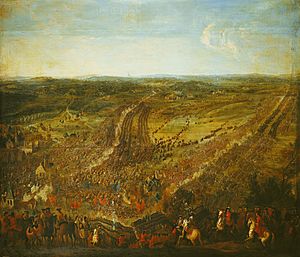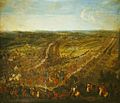Battle of Fleurus (1690) facts for kids
Quick facts for kids Battle of Fleurus |
|||||||
|---|---|---|---|---|---|---|---|
| Part of the Nine Years' War | |||||||
 Battle of Fleurus, Pierre-Denis Martin |
|||||||
|
|||||||
| Belligerents | |||||||
| Commanders and leaders | |||||||
| duc de Luxembourg | Prince of Waldeck | ||||||
| Strength | |||||||
| 30,000 35,000 40,000 70 guns |
30,000–38,000 90 guns |
||||||
| Casualties and losses | |||||||
| 3,600 6,000 7,000 |
19,000–21,000 | ||||||
The Battle of Fleurus was a big fight that happened on July 1, 1690. It took place near the town of Fleurus in what is now Belgium. This battle was a very important part of the Nine Years' War. During the battle, a French army, led by Marshal Luxembourg, won a major victory. They used a clever plan to surround and defeat the Allied forces, who were led by Prince Waldeck.
Even though the French won, King Louis XIV of France told Luxembourg to stop fighting in the Spanish Netherlands. Instead, he wanted Luxembourg to send troops to help the Dauphin on the Rhine River. The Allied forces went back to Brussels and weren't too worried about their loss. They believed they could replace their soldiers much faster than the French could.
Contents
Why the Battle Happened: The Background

In 1690, the main fighting of the Nine Years' War moved to the Spanish Netherlands. This area is now part of Belgium and the Netherlands. After a defeat in August 1689, Marshal Humières was replaced by Marshal Luxembourg as the French commander. Luxembourg stayed in charge until he died in 1695. His army was very strong, with many battalions and squadrons of soldiers. He could also get help from Marshal Boufflers if needed.
The Allied forces in the region were led by Prince Georg Friedrich of Waldeck. This was because King William was busy fighting in Ireland. Prince Waldeck wanted to wait before starting the campaign. He hoped that the Elector of Brandenburg would move his troops and keep Boufflers busy.
However, Luxembourg started his movements early. This allowed Boufflers to bring his troops to support the French commander. Waldeck, meanwhile, left his starting point and moved his army. He then spread out his troops to find food. After gathering his army again, Waldeck moved towards Genappe on June 8.
In mid-June, Luxembourg divided his forces. He sent some troops to guard certain areas. The main French army left Deinze and marched south. They crossed the Sambre River on June 23. More French troops joined Luxembourg's army. They continued their march, setting up camp at Boussu on June 27.
As Luxembourg moved his army south of Mons and Charleroi, Waldeck also moved his camp. On the same evening, Luxembourg personally led a group of soldiers. They used special pontoons to build a bridge across the Sambre River. A small fort was quickly captured by the French after they brought their cannons. French dragoons (soldiers who ride horses but fight on foot) also captured an enemy position. With the bridge safe, the rest of the French army crossed the Sambre on June 30.
Waldeck then moved his army towards the French bridge. French and Dutch cavalry (soldiers on horseback) had a small fight near Fleurus. By evening, the French cavalry had joined the rest of their army. They were only about 3 kilometers (2 miles) from the Allied forces.
The Battle: A Clever Plan
On the morning of July 1, Luxembourg marched his army towards Fleurus. Waldeck had placed his 38,000 troops in two lines. They were on high ground between the village of Heppignies on their right and the chateau of St Amant on their left. A small stream with high banks protected Waldeck's front. This made a direct attack very difficult.
Luxembourg decided to attack both sides of the Allied army at the same time. This was a very brave and risky plan. It needed to be kept secret and use trickery to work. The French army's first line split up. Some troops went between Heppignies and Fleurus. Others moved towards St Amant. The two groups on Luxembourg's right side moved north across the stream. Hedges and wheat fields hid their movement. French cavalry also helped to hide them. Forty cannons were placed near the chateau of St Amant. Another 30 guns were placed between the chateau and Fleurus.
Waldeck did not notice that Luxembourg had surrounded his army. If Waldeck had realized that Luxembourg had split his army, he might have attacked the French left side before the right side was ready. But he didn't. Once the French right side was in position, their cannons started firing around 10:00 AM. They hit the Allied soldiers very hard.
The French left side, led by Lieutenant-General Jean Christophe, comte de Gournay, started their attack with a cavalry charge. But Gournay was killed in the attack. His death and the shots from the Dutch soldiers made his cavalry confused. They went back to Fleurus to get organized again.
However, a French cavalry charge on the right side was more successful. They pushed back the Dutch cavalry. The French foot soldiers followed. Waldeck's forces were now surrounded. At this important moment, Waldeck and Aylva told the Dutch foot soldiers to form squares. This worked, and the French cavalry had to stop their attack. The French foot soldiers were ordered to march directly at the enemy. But they also failed to break the squares and suffered many losses.
Luxembourg saw that further attacks wouldn't work. He decided to break the Dutch soldiers by firing cannons at their tight squares from close range. He used cannons they had captured. To his surprise, even with many losses, the Dutch soldiers kept their formation. One of Luxembourg's helpers, who couldn't stand to see the bloodshed, tried to get them to give up. After the battle, Luxembourg wrote that the Dutch soldiers said: "Leave, we want nothing, and are strong enough to defend ourselves."
What happened next was a tough fight as the Dutch slowly retreated. Waldeck and Aylva moved their troops in squares towards Mellet and then to Brussels. The Dutch groups at the back formed a changing front to face the French. Under this protective fire, Waldeck's troops left the battlefield, even though the French tried to attack them several times. The Dutch right side, led by Henry Casimir II and the Prince of Nassau-Usingen, found safety near the cannons of Charleroi.
What Happened Next: The Aftermath
The Battle of Fleurus was one of the bloodiest battles of that time. Both sides had huge losses. Some historians say the French had about 3,000 killed and 3,000 wounded. The Allies suffered much more, with about 6,000 killed, 5,000 wounded, and 8,000 captured. The French also captured 48 cannons and 150 flags.
A French historian, François Guizot, said Fleurus was a complete French victory, but it didn't lead to much. Louvois, King Louis' war minister, wanted Luxembourg to immediately attack Namur or Charleroi. But King Louis was worried about his son's army on the Rhine. So, he told Luxembourg to send some of his troops to help his son and not to start a big siege. Louvois disagreed, but King Louis wanted to make sure nothing bad happened to his son's command. Still, Luxembourg was able to control much of the land east of Brussels.
Waldeck eventually went back to Brussels. There, his injured troops were replaced with soldiers from forts. About 15,000 Spanish troops joined the Allied army. Troops from Liège and Brandenburg also joined on July 22. By August 2, Waldeck's Allied army had grown to 70,000 men. With this large force, the Allied army marched to Genappe and then to Nivelles. After the battle, people in the Dutch Republic were somewhat happy. They believed the French had lost more soldiers, and that the French army was not in a better state to continue fighting.
The rest of the fighting season in the Spanish Netherlands was fairly quiet. Boufflers briefly joined his forces with Luxembourg's. But in late August, he returned to his area. After some small fights, both the Allies and the French went to their winter camps in October. Luxembourg made sure his men stayed in enemy territory. The Allies stayed in and around Maastricht. The Hanoverian soldiers went home, and many from Brandenburg and Lüneburg stayed in the forts of the Spanish Netherlands.
The French forced the prisoners of war they captured at Fleurus to join their army. They sent German prisoners to fight in Catalonia, Walloon prisoners to Germany, and Dutch prisoners to Savoy. However, many prisoners escaped and made it back to Allied lands.
See also
 In Spanish: Batalla de Fleurus (1690) para niños
In Spanish: Batalla de Fleurus (1690) para niños
Images for kids





